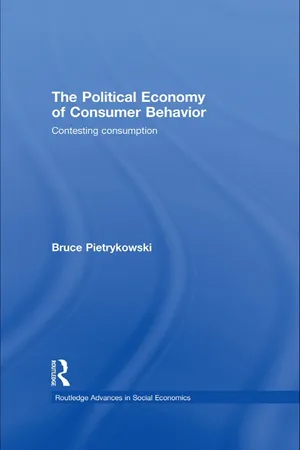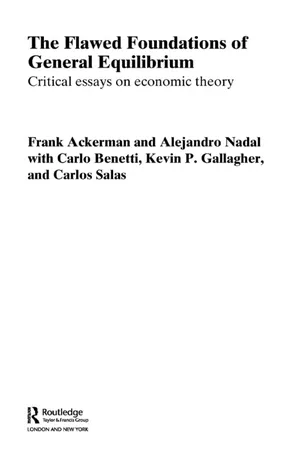Economics
Consumption Patterns
Consumption patterns refer to the way individuals or households allocate their spending across different goods and services. These patterns are influenced by factors such as income, preferences, prices, and cultural norms. Understanding consumption patterns is important for analyzing economic trends, forecasting demand for products, and formulating effective policies.
Written by Perlego with AI-assistance
Related key terms
4 Key excerpts on "Consumption Patterns"
- eBook - ePub
- Wim Hulleman, Ad Marijs(Authors)
- 2021(Publication Date)
- Routledge(Publisher)
Household expenditure is called consumption. We only call goods consumer goods after they have been bought by consumers. A piece of furniture that is still in the shop awaiting purchase belongs to floating capital (stock). Only after it has been bought do we speak of consumption. Consumers purchase a set number of goods and services to satisfy their needs. This is termed a consumption pattern. Consumption Patterns vary considerably. Consumers use a variety of different products to satisfy their needs. Consumer preferences differ. One consumer might have eating habits that cause him to consume a lot of fruit and vegetables, another consumer to frequent snack bars and a third consumer to dine in restaurants. Some consumers spend a lot of money on durable consumer goods while others have a preference for travel.Adding up all of the various items of expenditure of individual consumers gives us a macroeconomic consumer pattern. Figure 5.2 shows the macroeconomic consumer pattern for the EU.Source: EurostatFIGURE 5.2Consumption pattern EU, 2015Changes in consumer patterns
Chapter 2 has already dealt at length with consumer patterns, so a short commentary on Figure 5.2 will therefore do for our purposes.It is important for companies and industries to know what changes are occurring in their expenditure, because these changes will affect their own sales. Companies that were producing for growing markets in the past will find that their markets are becoming saturated, which will have consequences for competition.Income elasticityIn Chapter 2 we have seen that the income elasticity of expenditure can differ greatly. Foodstuffs have a lower income elasticity than services. At a constant increase in income, the ratio between expenditure on foodstuffs and services will change in favour of the latter. In 1994, consumers spent 16.1% of the total consumer expenditure on food; by 2012 this had fallen to only 12%. This drop is related to the low-income elasticity of foodstuffs. In the same period, expenditure on hotels and restaurants rose by a quarter. This reflects the high-income elasticity of this expenditure, in which the service component is much larger than it is for the sale of foodstuffs by retailers.Economic agencies often predict both long-term and short-term changes in consumption on the basis of income developments. These are the main influences. In the short term, a few others – distribution of income, capital development, consumer confidence and the interest rate – also play a role (see Figure 5.3 - eBook - ePub
- Bruce Pietrykowski(Author)
- 2009(Publication Date)
- Routledge(Publisher)
So, to better understand shifts in consumer spending we need to construct a richer account of consumer practices that encompasses a broader swath of human experience that extends beyond the marketplace. In this sense I want to de-center the market as the primary focus of attention for economists interested in explaining consumer behavior. In place of isolated, atomistic individuals buying their commodities in the market, I will argue that consumption is a socially constructed set of practices. Consumption involves social relations between individuals and groups ranging from family members to retail sales workers, advertisers, transnational corporations, entrepreneurs, government regulators, and other shoppers. Markets are economic institutions that shape our attitudes, beliefs and behavior (Lane 1991; Bowles 1998). But consumption also involves a set of social practices that extend beyond the point of purchase to include the formulation of demand and the transformation of commodities by means of using those commodities. Therefore, consumption involves multiple sites of social, cultural and material interaction.Voices of resistance to the model of self-interested consumer behavior or rational choice microeconomics do exist. On the one hand are economists who draw upon the intellectual traditions inspired by Karl Marx, Max Weber and Thorstein Veblen. From this perspective, consumption involves processes of conflict and control, group identification, status enhancement or status preservation, habitual forms of life and standards of living, and contestation over the meanings and uses of commodities. Economists sympathetic to this perspective are arrayed along a spectrum ranging from those who focus on consumption as a form of individual exploration and identity formation, to those who examine the ways in which demands and desires are artificially created and sustained by agents of the modern corporation through overt and covert (e.g. “buzz marketing”) forms of product advertising. These are important contributions to our understanding of consumer behavior. But taken to their extremes they result in the depiction of consumers as either free agents able to transcend limitations of class, gender, race, geography and income in their quest for novelty, meaning and identity or as dupes acting in the best interests of corporations and against their own individual or class-based interests. Also, these approaches tend to focus on the social aspects of consumer choices without explicitly taking into account either the historical development of consumer practices or the extension of consumption beyond the point of purchase. Instead, I argue that the development of consumer practices has historically been constituted by a set of forces, not the least of which is gender.3 - eBook - ePub
- Peter Catterall, James Obelkevich(Authors)
- 2002(Publication Date)
- Routledge(Publisher)
We can define consumption as the process in which goods and services are bought and used to satisfy people’s needs. It excludes ‘capital goods’, used in the process of production, and in this chapter I have also omitted goods and services provided by the public sector, which deserve separate treatment. Consumption is closely related to supply-side matters such as marketing and retailing. But the main focus here is on its three primary aspects: the buying of goods or services; their uses; and, not least, their meanings and cultural significance.It follows from this that consumption is not one activity but infinitely many. It varies from product to product and each has its own story: there is not much in common between the consumption of champagne and the consumption of shampoo. The best way to approach the subject is therefore not through grand theories of consumption in general but through detailed empirical research on a particular product or a particular group of consumers.At this point it is often assumed that since we are all consumers ourselves, such research is unnecessary—that we know everything we need to know about consumption from our own experience of watching television commercials and shopping in Sainsbury’s. If only things were so simple. Most of us know little enough about the consumer habits of the people next door, let alone those in another social class. Similarly with advertising: no matter how closely we examine a television commercial, we can never tell how other people have reacted to it, nor even what the intentions of the advertisers were.There has in fact been a good deal of serious and detailed research on post-war consumption: most of it, however, has been carried out not by sociologists or historians but by market researchers. Since 1945 they have become an essential part of the marketing process, and their work, generally superior to comparable studies by academics, yields a wealth of information and insight on consumer tastes and habits. That most of this material is confidential and closed to outsiders is a matter of regret.There nevertheless remains a great deal of evidence on consumption available to anyone willing to seek it out. Official sources include the indispensable Family Expenditure Survey and the National Food Survey. The published business and marketing sources include market reports and surveys such as Retail Business (1958—) and Mintel’s Market Intelligence (1972—), and specialised works like the National Readership Survey (1957). The trade press, probably richer and more extensive in Britain than in most other countries, is largely untapped; we have much to learn from journals like Chemist and Druggist, Domestic Equipment Trader and DIY Superstore. - Frank Ackerman, Alejandro Nadal, Kevin P. Gallagher(Authors)
- 2004(Publication Date)
- Routledge(Publisher)
5 Consumed in theory
Alternative perspectives on the economics of consumption
Frank AckermanIn many disciplines, the study of consumption has become a dynamic, changing field. A new interdisciplinary area of research on consumption has emerged in the past ten to fifteen years, drawing contributions and participants from sociology, anthropology, history, philosophy, literature, and marketing – even, on occasion, from economics. (See Miller (1995 ) for a collection of bibliographic essays and surveys from each of the relevant disciplines.) Yet despite the central role that consumption plays in economic theory, economics has been one of the least important contributors to the new wave of research – and one of the disciplines least affected by new approaches to consumption of any variety. A recent review of innovations in neoclassical economic theory simply asserts that “the microeconomic theory of consumer choice under conditions of certainty is well developed, and has not been the subject of any significant advances in recent years” (Darnell 1992: 1 ).Economists’ lack of interest in new approaches to consumption largely reflects the rigidity of the conventional economic theory of consumer behavior. That theory, of course, assumes that consumers come to the market with well-defined, insatiable desires for private goods and services; those desires are not affected by social interactions, culture, economic institutions, or the consumption choices or well-being of others. Only prices, incomes, and personal tastes affect consumption – and since tastes are exogenous to neoclassical economics, there is little point in talking about anything but prices and incomes.The correspondence between this theory and the visible facts of economic life is tenuous at best. If there have been no recent advances in the microeconomics of consumer behavior, it is not because of a lack of room for improvement. Nor has there been any scarcity of good critiques and suggestions of alternative theories in the economics literature. The problem is that the alternatives have been too quickly fragmented and/or forgotten.
Learn about this page
Index pages curate the most relevant extracts from our library of academic textbooks. They’ve been created using an in-house natural language model (NLM), each adding context and meaning to key research topics.



